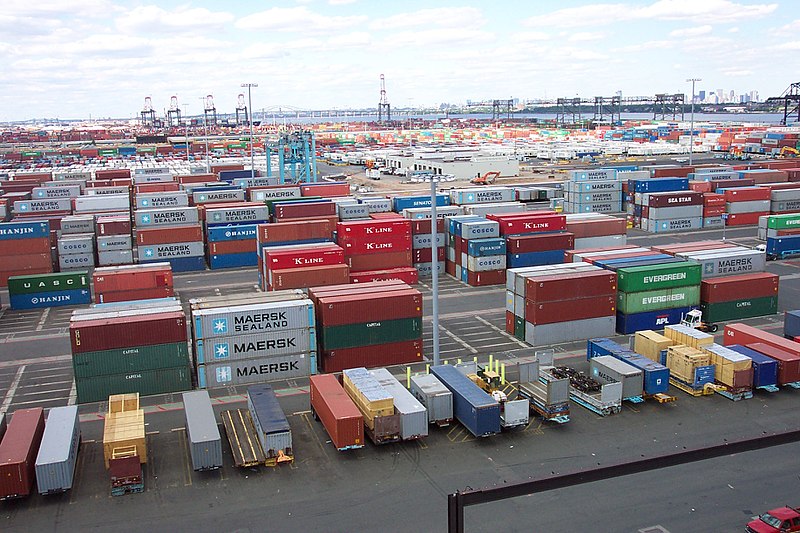Supply Chain Issues: What Is The Root Cause?
As The Holidays Quickly Approach, What Steps Do You Need To Take To Ensure You Have A Plan?
Captain Albert E. Theberge, NOAA Corps (ret.), Public domain, via Wikimedia Commons
Shipping containers sit idle in countries that don’t export many goods
We live in a time in which we are used to shopping online and getting everything we order within a couple of days, but ever since the start of the Covid-19 pandemic, we are unable to buy toilet paper and we are having to wait months for new cars and cell phones. Even more worrying is doctors not being able to get medicine out to their patients and

people in extreme climates are unable to acquire adequate equipment. Planes sit on the tarmac delayed, waiting hours for food deliveries. Why is this happening, you ask? It all boils down to the global supply chain. You may not think about it, but it’s the way all our goods get from where they’re manufactured, mined, or grown to where they need to be. There is a scarcity for a great number of high-demand products, which causes prices to go up. But when did all this start happening? In March 2020, the entire world went on lockdown, meaning workers who are major parts of the supply chain, such as those in factories, couldn’t go to work. As a result, factories in largely industrial countries like China, South Korea, and Germany had to shut down. Shipping companies saw this and reduced their schedules, anticipating a drop in demand. Peter Goodman of the New York Times was quoted as saying “this proved to be a terrible decision.” Demand did in fact decrease for some businesses and industries, such as restaurants, travel, and spa services. The problem with this was people were instead focusing their money on their homes, which quickly became classrooms and offices. People were also buying home improvement goods to fill the sudden abundance of time with renovations. But if this is the case, then why can’t the factories that were open produce more goods? Many did, but

the problem here is factories also rely on components produced elsewhere to produce the goods that they do. A good example of this is the microchips that are present in cell phones and cars. And even these chips need dozens of chemicals sourced from all around the world. The combination of high demand and a surprising lack of shipping containers caused prices to skyrocket and arrival times to be doubled or even tripled. The lack of shipping containers comes from them being shipped from countries like China to places like West Africa and Southeast Asia, where they don’t export much at all. This meant that shipping containers were quite literally stuck in Western Africa and Southeast Asia.

There is still hope, however. With the worst of the pandemic almost over, The White House said “businesses are adding new jobs at the rate of 540,000 per month,” and consumers are spending savings that they accumulated during lockdown, meaning “new home sales are at their highest level in 14 years, and auto sales are at their highest in 15 years.” But not all the data is good. Homebuilders are reporting shortages in materials such as lumber, wallboard, and roofing. Furthermore, in the motor vehicle sector, prices for new and used cars have increased. After the start of the pandemic, automakers underestimated the demand for cars after the pandemic, and because of this, they cancelled orders for parts called semiconductors. This is a big problem, because semiconductor chips have multiple stops in their manufacturing process, and some of these stops are factories that have shut down or have limited production. Pair that with the fact that the automobile industry isn’t the only one that needs the semiconductor chips, and the demand for the chips has never been higher.

Furthermore, the supply chain shortages have affected relief efforts and non profit organizations. They are no longer able to purchase excess inventory from profit-making companies because they are dealing with supply chain issues themselves. Is this all the pandemic’s fault? Actually, not entirely. Yes, the pandemic produced extremely volatile shifts in demand. Supply chains can’t keep up with this, but this also coincides with decades of companies keeping only the bare minimum in stock in order to keep prices low. Monopolistic tendencies also have an effect on shortages. For example, beef is scarce and prices are high, but this is because meatpackers have consolidated and eliminated some product in order to bolster prices and increase profitability. So, when will the shortages end? Unfortunately, no one really knows. These problems are likely to follow us into 2022, but the good news is many companies have ordered well ahead of time, meaning the problem will be less exaggerated during the holiday season.




